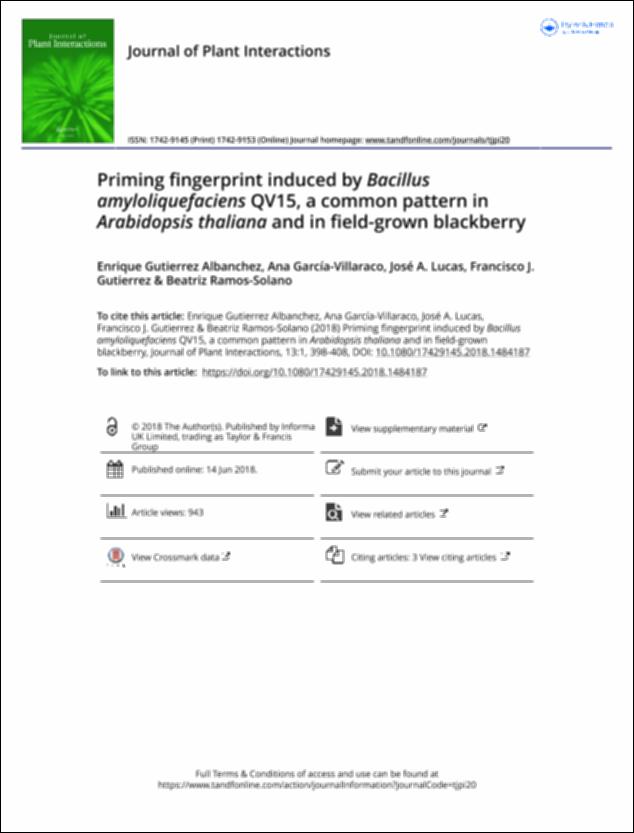Por favor, use este identificador para citar o enlazar este ítem:
http://hdl.handle.net/10637/15961Priming fingerprint induced by Bacillus amyloliquefaciens QV15, a common pattern in Arabidopsis thaliana and in field-grown blackberry
| Título : | Priming fingerprint induced by Bacillus amyloliquefaciens QV15, a common pattern in Arabidopsis thaliana and in field-grown blackberry |
| Autor : | Gutiérrez Albanchez, Enrique García Villaraco, Ana Lucas García, José Antonio Gutiérrez Mañero, Francisco Javier Ramos Solano, Beatriz |
| Materias: | Sistemas agrícolas; Plantas; Plagas agrícolas |
| Editorial : | Taylor & Francis |
| Citación : | Enrique Gutierrez Albanchez, Ana García-Villaraco, José A. Lucas, Francisco J. Gutierrez & Beatriz Ramos-Solano (2018) Priming fingerprint induced by Bacillus amyloliquefaciens QV15, a common pattern in Arabidopsis thaliana and in field-grown blackberry, Journal of Plant Interactions, 13:1, 398-408, DOI: 10.1080/17429145.2018.1484187 |
| Resumen : | The aim of this study is focused on determining the Bacillus amyloliquefaciens QV15 priming fingerprint in two different plant species, Arabidopsis and blackberry as a crop of agronomic interest, associated with protection upon pathogen challenge. To achieve this goal, Arabidopsis thaliana plants were challenged with Pseudomonas syringae DC3000 under controlled conditions, and field-grown blackberries were challenged by a powdery Mildew outbreak, finding plant protection in plants treated with QV15, in both conditions. Changes in ROS scavenging enzymes’ activity, defense-related enzymes’ activity and gene expression were evaluated in both plant species, before and after pathogen challenge, revealing the ability of this strain to prime both. As a result of this analysis, the priming fingerprint induced by QV15 was defined by a decrease in ROS scavenging enzymes’ activity in pre- and post-challenged plants, an increase in glucanase and chitinase activity after pathogen challenge, significantly increasing the expression of PR1, indicating a salicylic acid (SA)-mediated pathway activation. These results suggest an excellent potential of B. amyloliquefaciens QV15 to protect different plant species against different pathogens in field conditions. |
| URI : | http://hdl.handle.net/10637/15961 |
| Derechos: | http://creativecommons.org/licenses/by-nc-nd/4.0/deed.es Open Access |
| ISSN : | 1742-9153 |
| Fecha de publicación : | 14-jun-2018 |
| Centro : | Universidad San Pablo-CEU |
| Aparece en las colecciones: | Facultad de Farmacia |
Los ítems de DSpace están protegidos por copyright, con todos los derechos reservados, a menos que se indique lo contrario.


